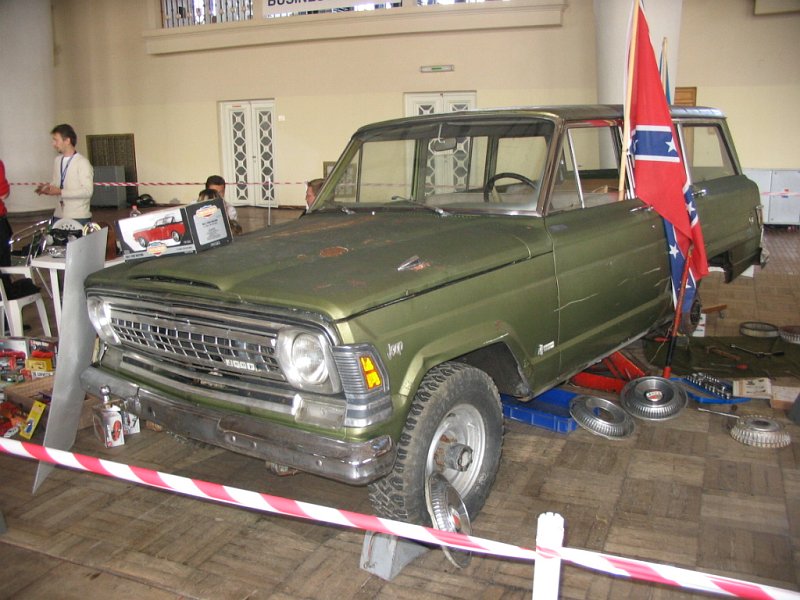Description
The Jeep Wagoneer was one of the most significant vehicles in automotive history, the model that effectively created the modern sport utility vehicle. Introduced in 1963, it combined the all-terrain capability of a four-wheel-drive truck with the comfort, style, and refinement of a passenger car. For more than 25 years, the Wagoneer remained the benchmark for luxury and versatility, outlasting every one of its competitors and establishing Jeep as the pioneer of the premium 4×4.
When the Wagoneer debuted under Kaiser Jeep, it represented a revolution in concept and design. Until then, four-wheel-drive vehicles were crude and utilitarian, built for work rather than comfort. The Wagoneer changed that completely. Designed by the celebrated industrial designer Brooks Stevens, it introduced elegant, timeless styling—tall, boxy, and purposeful, yet refined enough for suburban driveways. The front featured a simple horizontal grille flanked by round headlights, while its long roofline, squared-off fenders, and expansive glass area gave it a sense of openness and strength. The body-on-frame construction and solid axles ensured durability, but inside it felt like a family car rather than a farm truck.
Under the hood, the early Wagoneers were offered with a variety of engines, including a 230 cubic inch Tornado overhead-cam straight-six and, later, several V8 options. The most notable of these was the AMC 327 and, later, the AMC 360 and 401 cubic inch V8s, which gave the Wagoneer effortless performance and towing capability. Transmission options included manual gearboxes and smooth three-speed automatics, with power directed through either part-time or, eventually, full-time four-wheel-drive systems.
A key innovation arrived in the 1970s with Jeep’s Quadra-Trac system, one of the first full-time four-wheel-drive systems fitted to a passenger vehicle. Unlike earlier part-time systems that required the driver to manually engage four-wheel drive, Quadra-Trac used a center differential to automatically distribute torque between the front and rear axles. This gave the Wagoneer superior traction on slippery surfaces and allowed it to be driven in four-wheel-drive mode full-time without binding or noise—a huge step forward in convenience and safety. A vacuum-operated switch in the cabin allowed the driver to lock the differential when additional traction was required, giving the vehicle a seamless transition between comfort and capability.
As the years passed, the Wagoneer evolved from a practical family vehicle into a symbol of prestige. When American Motors Corporation (AMC) acquired Jeep in 1970, it recognized the model’s potential and refined it further. The interiors grew more luxurious, featuring thick carpeting, woodgrain dashboards, and soft upholstery. Power windows, air conditioning, and advanced sound systems became standard on upper trims, and Jeep offered distinctive color schemes and woodgrain exterior paneling that would become the model’s signature. By the late 1970s, the Wagoneer had transformed from a rugged 4×4 into a full-fledged luxury SUV, setting the template for vehicles like the Range Rover and the Chevrolet Suburban that would follow.
Despite its refinement, the Wagoneer never lost its fundamental toughness. It remained built on a sturdy ladder frame with leaf-spring suspension and solid axles at both ends. Ground clearance and approach angles allowed it to tackle challenging terrain, while its torquey V8 engines provided the pulling power needed for heavy loads or steep climbs. It was as comfortable hauling a horse trailer as it was gliding down a highway, and this dual capability became its defining trait.
By the 1980s, under Chrysler’s stewardship, the Wagoneer had achieved near-legendary status. The final version, the Grand Wagoneer, became an icon of American luxury motoring. It featured leather seating, deep-pile carpeting, cruise control, and signature simulated woodgrain side panels that had become inseparable from its identity. Though its basic structure dated back to the early 1960s, constant refinement had kept it relevant. Its mechanical simplicity and robust engineering gave it a loyal following among buyers who valued authenticity over novelty.
The driving experience of the Wagoneer was unlike anything else of its time. On the road, the long wheelbase and solid chassis gave it a sense of stability and composure that few other 4x4s could match. The ride was smooth and quiet, with the V8 delivering relaxed power and a deep, reassuring rumble. Off-road, it remained true to Jeep’s roots, capable of navigating trails, mud, and snow with remarkable confidence. The combination of full-time four-wheel drive, low gearing, and rugged suspension made it equally at home in the wilderness or on the boulevard.
Production of the original Wagoneer platform finally ended in 1991, making it one of the longest-running automotive designs ever produced. By then, it had earned a place as both a cultural and engineering landmark. Its influence could be seen in every luxury SUV that came after—from the Range Rover to the Cadillac Escalade—but few have captured its character.
Today, the Jeep Wagoneer is regarded as a classic and a collector’s favorite. Restored examples are prized for their craftsmanship and presence, while well-preserved originals remain admired for their durability and charm. The wood-panelled Grand Wagoneer, in particular, has become a symbol of understated American sophistication, representing an era when vehicles were built with mechanical honesty and timeless style.
The Wagoneer’s legacy lies in its perfect balance of comfort, capability, and character. It proved that four-wheel drive could be more than a tool—it could be a lifestyle. It was the first vehicle to make luxury and adventure compatible, paving the way for an entire industry. The Jeep Wagoneer didn’t just define the SUV; it defined the idea that freedom, refinement, and power could exist in one remarkable machine.
